Oct 27, 2017 | coins, commentary, grading, technology

SinoTech Stereo Microscope with USB interface
However, the area where they are lacking is the science of numismatics. The part where technology has been able to automate to perform mundane work and do the finest details that many factories have increased output while reducing the workforce. It is their inability to grasp new technologies that have been holding back the growth of numismatics.
Recently, someone with great numismatic credentials said that you cannot teach grading using computers.
When I was working in non-civilian agencies, we would call that BRAVO SIERRA (from the phonetic alphabet meaning “B.S.”).
It used to be that video technology prevented images from being shown in detail. This goes back to the day from the old television standards were the picture was 525 scan lines (the number of passes the across the screen it took to form the picture) drawn about 30 times per second (the frame rate). This was different from early computers that drew fine dots on the screen. At the point color monitors entered the market, most were 640 dots wide by 480 dots tall which was a little smaller than your standard television screen.
Technology has advanced beyond what we had with the old cathode ray tube (CRT) television and monitor. Now, you can buy a monitor that attaches to your computer that has the same resolution as your television. What we call “4K High Definition” is 4096 pixels wide by 2160 pixels tall or over six time the size of the old monitors.
The iMac I am using has a display that is 5120 pixels tall by 2880 pixels wide and the iPhone 6 Plus in my pocket has a display that has 401 pixels per inch resolution. Think about that for a moment… every square inch of an image will use 160,801 individual dots to display on a device that fits into my back pocket!
These monitors are not only larger but the pixels are denser, meaning they are smaller and closer together. When in the old days you can look into the television and see jagged edges, you closeup look now shows smooth lines.
Go look at the specification of the smartphones and tablets that are on the market. They make television that was being sold as little as 10 years ago look like something out of ancient history.
Cameras are also better. Most smartphones can shoot images of over 8 megapixels up to 20 megapixels with image sensors that surpass what was on the market as late as 5 years ago. The amount of image data these cameras can capture are remarkable!
Can you guess the grade?
There are a lot of industries that use this technology for critical image analysis. The growing telemedicine field uses the imaging to allow a doctor to examine patients from anywhere including some of the most rural parts of the world. A nurse in the middle of a jungle can draw blood, put the slide in a machine that will take images and perform other data analysis and send it back to a doctor thousands of miles away to help diagnose illnesses.
Manufacturers of parts for your automobile and the airplanes you fly us this image analysis to check for imperfections in metal parts including difficult to spot stress fractures to prevent breakdowns. That should be comforting driving down the road at 60 MPH or 30,000 feet in the air.
Even the food industry uses this imaging technology to prevent foreign substances from being packaged and landing on the grocery store shelf. Remember the opening theme from Laverne & Shirley where they are on the bottling line watching for bottles without caps? That job does not exist anymore. Computers with imaging technology not only watch for those bottles but can spot one that is not filled correctly and if something other than beer was placed in the bottle.
If we can trust the imaging technology for medicine, vehicle safety, and food integrity, why can’t we trust imaging technology to grade coins?
-

-
1965 Canadian Half Dollar
-

-
1965 Canadian Half Dollar reverse
Images taken with an iPhone 6 Plus
This is not to suggest that we can start grading coins by computer tomorrow but we can start soon. Programs have to be written to support the type of image analysis that would be required to determine an MS-69 coin from an MS-70. In fact, we may see fewer MS-70 coins using computer image analysis because the closer we look the more flaws we will find.
Professional Coin Grading Service provides the tip of this iceberg with the PCGS Photograde app. Whether you use the online service or one of the mobile apps, detailed imaging, and high definition displays can show you the details necessary. In fact, in a video PCGS produced about Photograde, they note how you can see the scratches on the imaged coin.
Images from PCGS Photograde App on the iPhone
If you can use the high definition images to see the details of coins, then the first step would be to use those images and the knowledge of grading to grade coins. Digital images can be transmitted anywhere there is a connection using the proper teaching platform.
With all due respect to the numismatic expert that said to me that you cannot teach grading using the computers, it is time to evolve from the early 2010s and see how technology has evolved to make it possible.
Oct 23, 2017 | coin design, coins, commemorative
Design of the 2018 Breast Cancer Awareness Commemorative Gold Coin was announced today on Fox 5 New York featuring interviews with New York Rep. Carolyn Maloney (D), the sponsor of the authorizing legislation (Public Law 114-148) and Myra Biblowit, President of the Breast Cancer Research Foundation, the organization that will receive whatever is collected from the surcharges.
No additional details were provided including the name of the winning designer or whether the silver dollar and clad half-dollar will have the same design.
Here is the video segment from “Good Day New York:”
Still frame of the reverse design also from “Good Day New York:”

Still frame of Breast Cancer Awareness commemorative coin reverse from Fox 5 NY
Summary of the Breast Cancer Awareness Commemorative Coin Program
- Commemorative coins issued in 2018
- Design, emblematic of the fight against breast cancer, selected from a juried competition with no less than $5,000 going to winning design
- “The Secretary shall encourage three-dimensional designs to be submitted as part of the proposals”
- 50,000 $5 “pink gold” coins with an alloy of at least 75-percent gold with a $35 surcharge
- 400,000 one-ounce silver dollars made with not less than 90-percent silver with a $10 surcharge
- 750,000 clad half-dollar coins with a $5 surcharge
- Surcharges will be distributed to the Breast Cancer Research Foundation of New York, to further breast cancer research funded by the Foundation.
Pink gold can be more commonly described as “rose gold.” Rose gold is an alloy of 75-percent gold with 20-percent copper and 5-percent silver. The color can be adjusted by changing the ratio of copper and silver.
Oct 23, 2017 | coins, currency, poll
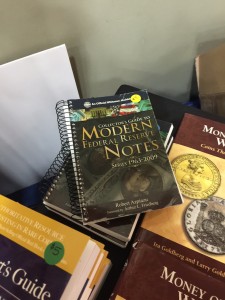 While thinking about modernizing the hobby it came to me that there is one aspect of the hobby that may still be stuck in the 20th century and that is price guides.
While thinking about modernizing the hobby it came to me that there is one aspect of the hobby that may still be stuck in the 20th century and that is price guides.
Price guides are supposed to be the guide that tells buyers and sellers the value of a coin. But over the years price guides went from being an art form to a statistical business with many different players vying for your attention.
Some of these guides have a good reputation while others may not be considered the best sources for prices. In either case, collectors have been known to use both the good and not so good to determine the price of their collectible because ultimately, the price is what you are willing to negotiate with the dealer to pay for the item regardless of what the guide says.
I started thinking, what do collectors use as their guide for pricing? Do they use more than one guide? If they buy a hardcopy (“dead tree edition”) do they buy new copies every year?
Today’s poll wants to know what you use to determine the price of your collectible or the acceptable price to buy or sell that special item.

Loading ...
Oct 20, 2017 | coins, commemorative, dollar
NOTE: I reached out to LeRoy Transfield, the winner of the design competition for the World War I Centennial Commemorative dollar coin to ask about his experience with the design competition. Yesterday, I posted a write-up he provided to me. Today, are his answers to additional questions I had.
-

-
2018 World War I Centennial Silver Dollar Obverse — “Soldier’s Charge” by LeRoy Transfield
-

-
2018 World War I Centennial Silver Dollar Reverse — “Poppies in the Wire” by LeRoy Transfield
Coin Collectors Blog: I see from your website that your expertise is sculpting larger works, such as statues. Were there techniques you have used in the past that helped you with the design process?
LeRoy Transfield: I haven’t done that many low relief sculptures before although I have had many years of experience in high relief. I mostly do the figure but from my early training in college I learnt that basic elements and principles of design plays a big role.
CCB: Did you have interaction with the selection committee? Did they ask for modifications, specifically based on their ability to strike a proper coin?
LT: I didn’t have any interaction with the committee other than when I spoke to them when they called me to say I won. They made some modifications to my submission such as making the rifle more accurate and the helmet more covered. The drawing they presented is actually not mine. I think there are problems with it such as around the eyes, proportions a little off on the soldier. But I think the final coin sculpted by Don Everhardt will look a lot better than that.
CCB: How were you notified that you won the competition?
LT: I was in Hawaii working on a project there which is a nice place to receive good news. They emailed me saying they wanted a conference call with me. It was 4 officials from the mint, The director, the head sculptor Don Everhardt, Meagan the project manager and one other can’t remember that one: sorry:8. I was informed I won and that the judging was unanimous that my design was outstanding among the entries. Don was very nice and said I did very nice figure work and that I had ‘nailed the design.’ I understand the project was his last sculpture before he retired. It was a very exciting time and a little stressful considering what it meant for the future and that I didn’t really think I would win since it was my first coin attempt. The $10,00 prize was also a great bonus and justified the summer I spent staring off into space, doodling and sitting around looking at war movies (Flags of our Fathers, Letters from Iowa Jima and Band of Brothers were my favorite).
CCB: Now that you won your first design competition for the U.S. Mint, would you consider entering another? Would you consider becoming a member of the U.S. Mint’s Artistic Infusion Program?
LT: I am a finalist for the Apollo 11 coin which we have already submitted our entries to. I as in my WW 1 coin design, I am pleased with what I came up with and whether it does well or not, I am happy to have to judged and my initials to the coin if it does win. I think this competition will be interesting because they said they will post the entries online but the committee will make the final decision. I didn’t enter the Breast Cancer Awareness coin because at the time I couldn’t think of anything that would say that in a coin. I could have thought of some cool designs but nothing (appropriate) to say oh yes that coin is to do with breast cancer.
I would become a member if they asked. I think sometimes the coins the mint puts out are too illustrative and rely too much on technology (such as Z brush). Coins are very hard to design especially in low relief since there are so many rules and so many things that look bad when translated to low relief. In the end I would use the ultimate test I do on any sculpture I make, to stand well back and be as objective as possible and say-does it look any good?
I would like to thank LeRoy Transfield for his time!
Oct 19, 2017 | coin design, coins, commemorative
NOTE: I reached out to LeRoy Transfield, the winner of the design competition for the World War I Centennial Commemorative dollar coin to ask about his experience with the design competition. He sent me a copy of his story with permission to publish it here. The following is what he sent. I had additional questions. Those will be published tomorrow.

LeRoy Transfield
Secondly, I was excited because I am a sculptor and love sculpture of all kinds. My specialty is sculpture in the round, figures, people. I have done very few low relief sculptures and no coins. Despite this, I enjoy looking at well-sculpted coins and even have a small coin collection of my own. My favorite American coin is the Standing Liberty quarter by Hermon MacNeil.
Thirdly I have done a number of war memorials for local towns in the area including the city I live in. During these experiences, I have gotten to know many veterans and people that fought in most of the major wars of the 20th century. Many of them including people I worked very closely with are now gone. But I often think of them and how their lives have touched mine.
Last, I was inspired by my own family. Both extended and immediate. I have been supported and helped over the years and always feel grateful for their support. Also, my Great Uncle on my mother’s side actually fought in World War One as part of the Maori Battalion. The Maori Battalion were part of the New Zealand Expeditionary Force to aid the allies. The Maori are the indigenous people of New Zealand.
All this excitement and energy flowed through me when I first got the news that I was a finalist. I so wanted to create a great design! Even though I had seen many WW I movies already and new the history, I review many pictures, books, films and documentaries to focus on the American role in the war.
I also looked at great coins. Not so much as to get an idea for a design or copy them, but to dissect those good coins and figure out what made them so good compared to average coins and what rules helped them achieve such inspiring results. I wanted an original design but one that followed those lines of greatness.
I thought about the poem, In Flanders Fields and thought Poppies would be a good thing to put in there somewhere. I also thought of the armistice and how excited everyone was when the hour came. A peace that may well not have happened without American support.
With all these thoughts, I started drawing images. I drew for two weeks. Ideas and designs of mostly soldiers in different poses that could easily be accentuated in a relief coin design. After this I started making clay versions of my sketches and quickly realized the drawings were useless and didn’t help me see problems in the design once it was built up in clay.
After about 4 or 5 weeks I was hitting a wall. No really good design was standing out from the numerous changes and trials I had done. The mint offered a conference call to all 20 participants to go over any questions we might have. This was of great help. In the call, I asked, what is the most common mistake made by beginning coin designers. The person, I forgot his name, said the most common mistake was adding too much detail to the 8-inch mock-up because one has to keep in mind that the final will be only 1.5 inches and much of the detail will be lost. Even though I already knew this it sank in even more. The other impression I got from the call was that the mint is really leaving things open to the finalists and wants to see what we can come up with, and not worry a whole lot about whether the design is right for coining as they have sculptors would fix those problems. They just wanted to see what we could come up with.
The first thing I did was scrap the board I was working on. At 18 inches, it was way too big. I thought that in working larger than the required 8 inch casts to be submitted, I could make a good large design and boil it down to a really good 8-inch final. Instead, I went the opposite way and started to work smaller than the 8 inches to get a better feeling of a coin. I started sculpting on 4-inch wood discs. This really helped a lot. It made it way easier to make a quick design and
help me see if it was going to work. I finally came up with the soldier profile, collar up and a rifle slung over his shoulder. This was not the final design but a good starting point. As I had the soldier in profile worked up, I wanted to add to it but knew not what it needed. That night I had barbed wire going through my head. Soldiers charging barbed wire, wire in the dirt and finally somehow, wire on my relief sculpture. After dreaming about barbed wire, I went to the piece and add the two small strands of wire in opposition to the rifle and the soldier. The hands also seem a natural thing to add and just like that I had the design for the Obverse.
I was very demanding on myself and didn’t say, that’s it, that’s the one. What I said was that’s a good Obverse, now make another. Another one never came. I was running out of time so I decided then to make that my Obverse and put my thoughts into the reverse. I actually thought I had a good idea already, an eagle. It was going to be a diving eagle, in profile, with wings outstretched holding arrows and an olive branch. In the eagle’s beak would be a banner with the words e plurubus unum. In the background would be a map of Europe. I just knew it would look good. But when I fleshed it out it looked terrible!
I looked for another idea. It had to be as good as the soldier. The eagle didn’t work but I wanted to try a bird again and knew that carrier pigeons were used a lot in World War One so I decided to use a pigeon. I looked at many pigeons and pigeon photos and sculpted up something I thought looked ideal. This was good because the time for submitting was running out! I had only three days left.
With the pieces molded and cast to the 8 inch specifications I had the two designs. The soldier looked good. I had different thoughts about the pigeon. I sculpted the bird as best I could but the final reverse looked not near as good as the obverse. I was dumbfounded. I had to send the pigeon, time was up, I had no time to make another. But as I looked at the pigeon I became more and more alarmed to the point where my stomach ached to look at it. I was tired of the whole project.
I thought I should just send it and be done with it. But on more reflection, I just couldn’t do it, I couldn’t send it!
Firstly, I thought of the embarrassment of the committee seeing this lousy pigeon. I wouldn’t be there, I reasoned, but that didn’t help. Sure, they might like the soldier, perhaps they will choose that and another reverse. Even so I just couldn’t send it. So, I did a thought conversation and said to myself if you don’t like it they make something else, in your style, that you do like. Even if the committee doesn’t like it at least you can be happy with what you send and no regrets. But then I would vacillate back to you have run out of time just send it and be done with the thing.
At that time, my daughter wanted to go on a 9-mile bike ride up Provo Canyon, a favorite summer activity and jump off a local bridge into the chilling Provo river. School was about to start so this would be one last activity with my daughter. The ride there took about an hour. In retrospect, this time away made all the difference in my final decision to send a different reverse. As I left and rode away from my work I had a greater perspective. I could see I had learnt a lot in the last 10 weeks about coin sculpting and may well be able to come up with a good design in two days. Halfway into my ride I convinced myself that the pigeon had to go and now, what was I going to do to replace it? As we got to the bridge I came back to the beginning, poppies. But poppies are a little uninteresting and not that good looking in relief coin sculpture. So, my next thoughts were how to make the poppies look better.
This was all going on while I was enjoying the summer weather and river water with my daughter. To jump into the river, one would climb up on a steel rail about 4.5 feet above the bridge, balance there and jump into the water 15 feet below. It was exhilarating. Standing on top of the rail is quite an inspiring thing. The beautiful canyon, trees, rocks, and water looked awesome. I often thought that on a stormy day a bolt of lightning could easily find its way to the person standing perched so high on the bridge. As I stood there I thought came to me of using the barbed wire again in contrast to the poppies. I’ve got it I said and jumped into water fridge water. I had it all now, in my mind.
All I needed to do was go home and put in down in clay. When I got home my wife to catch up with me on her day. We talked about the recent passing of my old sculpture teacher and some of the funny stories he would tell us students. All this time I was sculpting the poppies and the wire. In an hour, it was done. That’s it! I said. I was unsure if it was a winning design but it was a design I could put my name to and come what may, I wasn’t embarrassed.
The plaster casts made it to the US mint the very last day of the deadline.
Portrait of the LeRoy Transfield taken from the artist’s
website.
Oct 18, 2017 | cents, coins, currency, dollar, Federal Reserve, US Mint
Could the recent cyber attacks and growing severity of cybersecurity issues become the motivation for Congress to vote to reform United States currency?
According to Philip Diehl and Edmund Moy, former Directors of the U.S. Mint, the discussion as to remove the cent and paper dollar from circulation should be part of the current budget and tax overhaul debates.
-
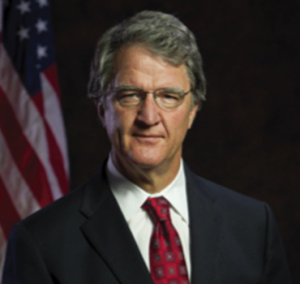
-
Philip N. Diehl
35th Director of the U.S. Mint
June 1994 — March 2000
-

-
Edmund C. Moy
38th Director of the U.S. Mint
September 2006 — January 2011
The discussion is the same as it has been. The cost of zinc has risen causing the manufacturing costs of the Lincoln cent to climb above its face value. Even with operating efficiencies that have brought down the cost of manufacturing to its lowest levels in many years, the price of zinc keeps makes the materials cost more than the coin is worth.
As for the paper dollar, the Government Accountability Office has published several reports over the years that demonstrate the cost savings between using the paper dollar versus a coin dollar. The last GAO report (GAO-13-164T) concluded that using a dollar coin instead of the paper note “could potentially provide $4.4 billion in net benefits to the federal government over 30 years.”
This is not a new discussion. The only change is that this is being suggested by former Directors of the U.S. Mint from both sides of the aisle. Diehl was appointed by Bill Clinton and served from June 1994 through March 2000. Moy was appointed by George W. Bush and served from September 2006 through January 2011.
Earlier this year, Sen. John McCain (R-AZ) introduced the Currency Optimization, Innovation, and National Savings Act of 2017 (COINS Act) (S. 759). McCain’s bill would require:
- Suspending the production of the one-cent coin for 10 years except for collectibles. After three years, the GAO would doe a study to determine whether production should remain suspended or should be reinstated. This would not demonetize the cent.
- Change the composition of the nickel to 80-percent copper and 20-percent nickel. This should bring down the cost of materials used in striking the five-cent coin to be on par with its value. Efficiencies in manufacturing could lower costs further.
- If the bill becomes law, two years after it is enacted, the Federal Reserve will begin removing $1 Federal Reserve Notes from circulation. This will probably be done by the banks who will take the notes on deposit and send them back to the Federal Reserve where they will be destroyed. Coins would take their place. The $1 FRN could still be produced for the collector market.
Sources report that the chances of McCain’s bill getting a hearing are minuscule. While having lunch with on congressional staffer, I was given three reasons why Congress will not address this issue:
- States with a large rural population primarily west of the Mississippi River represented by Republicans are unlikely to support the removal of the one-cent coin. Removal of the coin is viewed as a hidden tax against the people with fear mongering that suggest the government is keeping the extra money that would become on the rounding of prices.
- States with large poor populations, primarily in the south, and their advocates who believe that taking away the pennies are a way to separate more money from poor people who can least afford to lose the ability to pay in cents.
- Surveys show that most of the people older than Millenials are against removing the paper dollar. Since this population constitutes the majority of the voters and donors, the politicians are not about to make those people upset.
Another issue is that McCain is not popular amongst his fellow Republicans. If the issue is addressed, it is likely to be discussed as part of a bill that does not bear McCain’s sponsorship.
Given the partisan nature of politics and the perceptions of the members of Congress, there is a very little chance of the Coins Act or any similar legislation being enacted during this session of Congress.
Oct 15, 2017 | Britain, coins, foreign

The old Round Pound and the new 12-sided £1 coin
British news outlets are reporting that millions of the old round pounds are still in circulation but that might not be bad news for many Britons. There are reports that many coin-operated systems have not been converted to take the new 12-sided £1 coin including supermarkets, where a £1 pound coin is necessary to “rent” a trolley, what the British call their shopping cart.
Two of the U.K.’s largest grocery store chains have announced they will continue to accept the round pound through the end of October because their trolley systems are not ready.
Charities are getting into the act by accepting the old round pound as donations. Many charities will continue to accept the coin through the final redemption period in March 2018 as donations. The charities are working with banks to deposit the coins.
It has been fascinating to read the news of how the U.K. has tried to adapt to the new coin. The biggest issue has been with the use of coin-operated equipment like trolley rentals and parking meters. It is a lesson to any active economy, such as her in the United States, as to what could happen should the composition of U.S. coins change.
Although there have been discussions as to whether to change the composition of United States coinage, it is not likely to happen for many reasons. What may be gaining support is dropping the $1 Federal Reserve Note in favor of a dollar coin. This would not require changes in coin-operated systems but a change in attitudes. Given how resilient Americans can be, it would be possible to end production of the $1 FRN and just endure the kvetching that will ensue. That will end when people get used the coin.
And now the news…
October 9, 2017
LeRoy Transfield A photo of the New Zealand Expeditionary Force, Native Contingent. Utah sculptor LeRoy Transfield had two uncles who served in the unit during World War I. → Read more at deseretnews.com
October 11, 2017
The discovery of gold rings and coins on a Swedish island sheds new light on the history of the area, and could give insight into the motives for a massacre which took place in the fifth century, archaeologists told The Local on Wednesday. → Read more at thelocal.se
October 12, 2017
Share → Read more at adweek.com
October 12, 2017
People buy gold in various forms like jewellery, coins etc. Here are 7 things to know if you are buying gold coins this Diwali. → Read more at economictimes.indiatimes.com
October 13, 2017
The Carl Brashear Foundation wants to bring its namesake’s legacy home to the veterans center that soon will bear his name. → Read more at thenewsenterprise.com
October 14, 2017
By Katie Lange Defense Media Activity → Read more at dodlive.mil
October 15, 2017
Shoppers have one day left to spend their old round £1 coins before they cease to become legal tender at midnight. Hundreds of millions of round pounds are yet to be handed in, as only hours remain before the coin drops out of general circulation. However, major banks and building societies have said they will continue to accept the old coins after the deadline on Sunday. They can also be deposited into any of the usual high street banks or through the Post Office. → Read more at independent.co.uk
October 15, 2017
Sunday, October 15, 2017 → Read more at jamaicaobserver.com
October 15, 2017
Currency modernization will help secure our financial futures and save billions of dollars for taxpayers. → Read more at cnbc.com
Oct 13, 2017 | coins, commemorative, news

Secretary of the Interior Ryan K. Zinke
In an article that appeared in The Washington Post, it was reported that Secretary of the Interior Ryan Zinke has the department fly a special flag on top of the agency’s building in Washington, D.C. when he is in the office. On days Zinke is not in the office, a flag is raised for Deputy Secretary David Bernhardt.
Zinke, the former Montana congressman, is a former Navy SEAL commander and may have adopted this tradition from his time in the service.
Zinke also commissioned personalized challenge coins to give to staff and visitors.
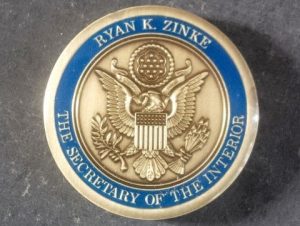
Challenge Coin commissioned by Interior Secretary Ryan Zinke
Typically, a challenge coin is a small medal, usually no larger than 2-inches in diameter, with the insignia or emblem of the organization. Two-sided challenge coins may have the emblem of the service on the front and the back has the emblem of the division or other representative services. Challenge coins are traditionally given by a commander in recognition of special achievement or can be exchanged as recognition for visiting an organization.
Receiving a challenge coin, especially from a high ranking official is supposed to be considered an honor.
Over the last 15 years, challenge coins became popular outside of the military as retired service members began to work in other areas of the government. The tradition has even been adopted by state and local governments and sometimes used to help raise money for municipal projects.
While most agencies have challenge coins, Zinke may be the only secretary to have one personalized. There was no report on the cost of the coins to taxpayers.
Although having a personalized challenge coin along with his flag ritual is unusual for a Cabinet-level official, there appears nothing wrong with him doing this. Zinke appears to have enthusiastically embraced his job at the Department of the Interior and if he uses the challenge coin to help reward department employees, then this is a good move on his part.
Credits
- Official portrait of Secretary Zinke courtesy of the Department of the Interior.
- Zinke Challenge Coin image courtesy of The Washington Post.
Oct 12, 2017 | Britain, coins, counterfeit, errors, foreign
 As the British are winding down the use of the Round Pound, stories are once again popping up about errors of the new 12-sided pound coin being sold for high prices on eBay.
As the British are winding down the use of the Round Pound, stories are once again popping up about errors of the new 12-sided pound coin being sold for high prices on eBay.
Although the Royal Mint has admitted to manufacturing issues in trying to produce enough new pound coins to satisfy circulation requirements, their claim that the number of errors where the center are missing of the bi-metallic coins is likely post-minting errors.
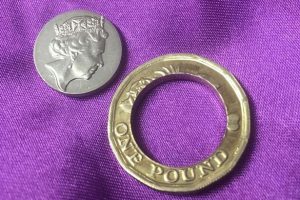
A weak strike can prevent the two metals from fusing properly allowing them to separate
To better understand why it is being claimed these are post-mint errors, I contacted a European-based dealer who has relationships with many of the continent’s mints. What follows is a summary of his explanation.
The Royal Mint coins money in a process similar to any other mint. Planchets are prepared, sent the coining press, stamped, dumped into a hopper, and sent down a conveyor where they are bagged. The bags are weight to a precise weight before the bags are accepted. Along the way, there are cameras and other sensors to detect errors.
All of the checks and sensors, including the weight of the coin, would be caught long before reaching the bagging section. Aside from the dimensions not being correct, the weight of the ring or center by themselves would not be up to the standard.
It is possible that the coins could separate in the bags during transport. However, these coins are transported to government authorized handlers. Some of them are similar to the companies that drive armored trucks here in the United States. They take the coins and prepare them for delivery to the banks.
The preparation process requires coins to be counted, rolled, and bagged. As part of the process, the coins are loaded into a system that transfers them to an automated line that brings the coins by conveyor to a machine that will either roll them or dump them in a bag. In both cases, the contents are limited by the amount they hold.
As part of the automated system, the coins are counted and check for size and weight so that if there are any coins that do not meet the Royal Mint’s standards are removed. The automated system would catch the ring and the center if they separated before the process.
Coins that are to be rolled are sent to a machine to roll them where they are counted and placed in rolls of £25 each. Those rolls are for bank and retail use and handled accordingly.
Bagged coins are used by bulk handlers such as the coin-op industry. Bags with £100 of coins are counted before being placed in the bag. If the coin cannot be verified before it is placed in the bag then the coin is rejected.
Is it possible for the coin to separate in the £100 pound bag prior to circulation? Of course, it is. However, there is one more check before the coins reach the consumer, and that is the coin-op machine itself.
Coin-op machines have mechanisms to try to prevent accepting counterfeit money and to ensure it is giving the proper change. Machines just do not eject any coin in its hopper. These checks include the weight, dimensions, and magnetic signature. The magnetic signature measures what happens after magnetic energy is flashed on the coin. Think about it as measuring how the coin would reflect light but use magnetism instead.
A pound coin that had separated would not pass the magnetic signature test and be rejected.
Although there are a number of points along the process that could fail, the number of checks between the Royal Mint and the consumer, it is highly unlikely that all of these separated pound coins exist.
It is possible that the coins being sold are from the reject bins of coin-op machines. However, the dealer I spoke with is suspicious of the number of coins being sold.
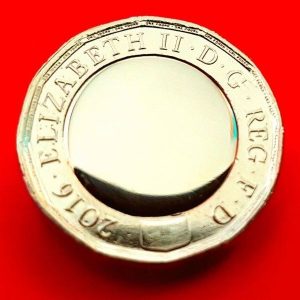
Trial strikes found without the effigy of Queen Elizabeth, II
My dealer contact said that nobody should pay more than “three-and-a-half quid” (£3.50 or $4.64 at the current exchange rate) for just a 12-sided pound outer ring. Even if it is not a legitimate Royal Mint error it is a nice conversation piece.
Examples of legitimate 12-sided £1 coin errors
-
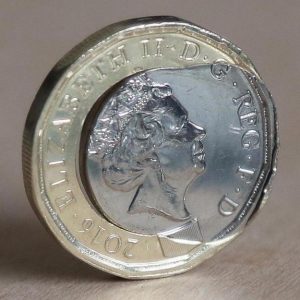
-
Too hard of a strike is likely to have caused the copper-nickel center to melt across the coin.
-
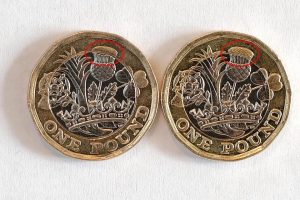
-
First new £1 coin error found with missing detail on the thistle
Oct 11, 2017 | celebration, coin design, coins, commemorative, US Mint
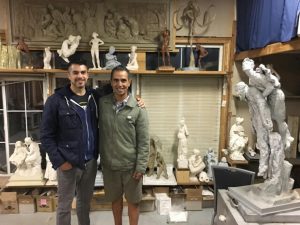
Utah sculptor LeRoy Transfield, right, poses in his sculpting studio in Orem.
The winning design was submitted by LeRoy Transfield, a sculptor from Orem, Utah.
In an interview that appeared in the Desert News, Transfield said that he had two uncles that served as members of the New Zealand Expeditionary Force Native Contingent during World War I. This lead to his interest in learning about the history of the war.
-

-
2018 World War I Centennial Silver Dollar Obverse — “Soldier’s Charge” by LeRoy Transfield
-

-
2018 World War I Centennial Silver Dollar Reverse — “Poppies in the Wire” by LeRoy Transfield
For the obverse, Transfield titled it “Soldier’s Charge.” In the interview, Transfield said that he “didn’t want him to look like some model in an artist’s studio. I made his nose like it might’ve been broken. I wanted to give him a rugged looking face. … I wanted that feeling of combat”
Transfield said that the reverse was more difficult to for him to design. After several tried he came up with the “Poppies in the Wire”
In 2012,
I wrote about the poem “In Flanders Fields” and suggested that it be adopted on a U.S. commemorative coin. It only took five years for my suggestion to become a reality! You can read about the poem and my recommendation
→ here.
Poppies are a fitting tribute since their use was inspired by the poem “In Flanders Fields.” The poem was written by Lt. Col. John McCrae, a Canadian physician following the funeral of a friend and fellow soldier who died in battle. It was published in 1915 and first adopted by the American Legion to commemorate the American Soldiers killed in the war. It was later adopted by veterans groups within the British Empire including Canada.
Transfield is originally from New Zealand but moved to the United States to attend BYU-Hawaii. After graduating with a Bachelors of Fine Arts degree, he moved with his wife to Orem where he operates a sculpting studio in his garage.
Based on the line drawing, it appears that this is going to be an excellent design when struck on a 40mm silver planchet. This is one time where it appears that the Citizens Coinage Advisory Committee and the U.S. Commission of Fine Arts got it right in picking the design.
The World War I American Veterans Centennial Commemorative Coin will be issued in 2018. According to the law (Public Law 113-212) , the U.S. Mint is limited to selling no more than 350,000 silver dollars. Each coin will have a $10 surcharge (a maximum of $3.5 million) will be paid to the U.S. Foundation for the Commemoration of the World Wars to assist the World War I Centennial Commission in commemorating the centenary of World War I.
Given the texture in the both the soldier on the front and the poppies on the reverse, it will be interesting to see if the U.S. Mint comes up with an enhanced uncirculated version. It could be extraordinary!
Credits
- Image of LeRoy Transfield in his studio courtesy of the Desert News.
- Coin line art images courtesy of the U.S. Mint.

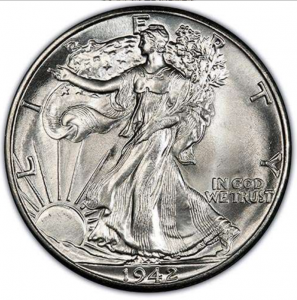
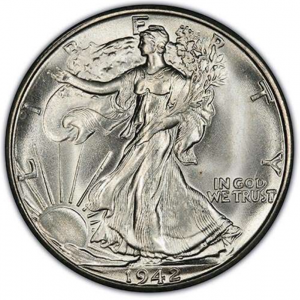




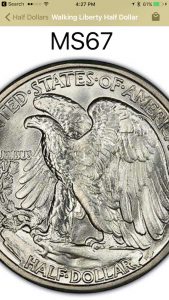

 While thinking about modernizing the hobby it came to me that there is one aspect of the hobby that may still be stuck in the 20th century and that is price guides.
While thinking about modernizing the hobby it came to me that there is one aspect of the hobby that may still be stuck in the 20th century and that is price guides.













